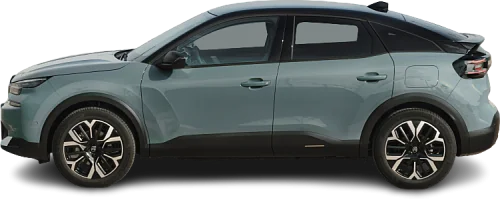USA EV Comparison: Citroën e-C4 50 kWh vs Nissan Leaf 40 kWh
Struggling to Decide? Let AI Help!
Your AI Summary Is Ready!
General Info
While the Citroën e-C4 50 kWh (2024-…) is currently produced, it is not offered for sale in the United States. The Nissan Leaf 40 kWh (2022-2025) has been discontinued. You can find it for as low as $9999 on the used car market.
The two vehicles share the same body style: Hatchback.
| Property | Citroën e-C4 50 kWh | Nissan Leaf 40 kWh |
|---|---|---|
| Years of Production | 2024-… | 2022-2025 |
| Current Status | Produced | Discontinued |
| Country of Manufacture | Spain | Japan, UK, USA |
| Body Style | Hatchback | Hatchback |
| Market Availability | EU | EU, USA |
| Price USA (Used) | - Price USA (Used) | $9999 |
| GCC Score | 5 | 4.8 |
Range and Efficiency
The Citroën e-C4 50 kWh (2024-…) boasts a greater real-world range, a larger battery, and superior energy efficiency compared to the Nissan Leaf 40 kWh (2022-2025).
| Property | Citroën e-C4 50 kWh | Nissan Leaf 40 kWh |
|---|---|---|
| Range (EPA) | - Range (EPA) | 149 mi |
| Range (WLTP) | 220 mi | 177 mi |
| Range (GCC) | 189 mi | 148 mi |
| Battery Capacity (Nominal) | 50 kWh | 40 kWh |
| Battery Capacity (Usable) | 46.3 kWh | 39 kWh |
| Efficiency per 100 mi | 24.5 kWh/100 mi | 26.4 kWh/100 mi |
| Efficiency per kWh | 4.08 mi/kWh | 3.79 mi/kWh |
| Range and Efficiency Score | 6.5 | 5.5 |
Charging
Both vehicles utilize a standard 400-volt architecture.
The Citroën e-C4 50 kWh (2024-…) offers faster charging speeds at DC stations, reaching up to 100 kW, while the Nissan Leaf 40 kWh (2022-2025) maxes out at 50 kW.
The Citroën e-C4 50 kWh (2024-…) features a more powerful on-board charger, supporting a maximum AC charging power of 7.4 kW, whereas the Nissan Leaf 40 kWh (2022-2025) is limited to 6.6 kW.
| Property | Citroën e-C4 50 kWh | Nissan Leaf 40 kWh |
|---|---|---|
| Max Charging Power (AC) | 7.4 kW | 6.6 kW |
| Max Charging Power (DC) | 100 kW | 50 kW |
| Architecture | 400 V | 400 V |
| Charge Port | CCS Type 2 | CHAdeMO |
| Charging Score | 4.3 | 3.3 |
Performance
Both vehicles are front-wheel drive.
The Nissan Leaf 40 kWh (2022-2025) boasts greater motor power and accelerates faster from 0 to 60 mph.
| Property | Citroën e-C4 50 kWh | Nissan Leaf 40 kWh |
|---|---|---|
| Drive Type | FWD | FWD |
| Motor Type | PMSM | PMSM |
| Motor Power (kW) | 100 kW | 110 kW |
| Motor Power (hp) | 134 hp | 148 hp |
| Motor Torque | 192 lb-ft | 236 lb-ft |
| 0-60 mph | 10.4 s | 7.7 s |
| Top Speed | 93 mph | 90 mph |
| Performance Score | 2.6 | 3.1 |
Dimensions
The Nissan Leaf 40 kWh (2022-2025) stretches out longer, while the Citroën e-C4 50 kWh (2024-…) compensates with a wider stance. As for height, they’re nearly identical, so headroom should be comparable.
Both models have similar wheelbase lengths.
| Property | Citroën e-C4 50 kWh | Nissan Leaf 40 kWh |
|---|---|---|
| Length | 171.7 in | 176.4 in |
| Width (with Mirrors) | 80 in | 79.9 in |
| Width (w/o Mirrors) | 72.2 in | 70.5 in |
| Height | 60 in | 61.5 in |
| Wheelbase | 105.1 in | 106.3 in |
Cargo and Towing
The Nissan Leaf 40 kWh (2022-2025) features a larger trunk, but the Citroën e-C4 50 kWh (2024-…) offers greater maximum cargo capacity when the rear seats are folded.
Neither car is equipped with a frunk (front trunk).
Neither vehicle is officially rated for towing in the US.
| Property | Citroën e-C4 50 kWh | Nissan Leaf 40 kWh |
|---|---|---|
| Number of Seats | 5 | 5 |
| Curb Weight | 3386 lb | 3509 lb |
| Cargo Volume (Trunk) | 13.4 ft3 | 23.6 ft3 |
| Cargo Volume (Max) | 44.1 ft3 | 30 ft3 |
| Cargo Volume (Frunk) | - Cargo Volume (Frunk) | - Cargo Volume (Frunk) |
| Towing Capacity | - Towing Capacity | - Towing Capacity |
| Cargo and Towing Score | 4.3 | 4.5 |




